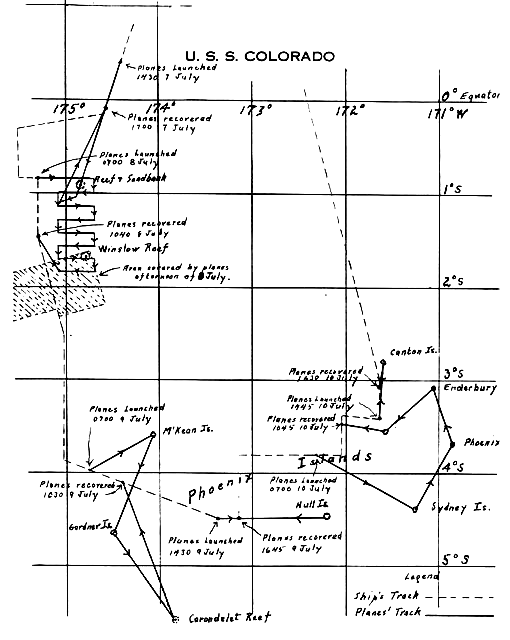Also there is a diagram of the flight in Lambrecht’s report.
There is?
http://tighar.org/Projects/Earhart/Documents/Lambrecht%27s_Report.html
Since it's near the equator, each degree on that map (both longitude as well as latitude) represents a distance of approximately 60 nautical miles, or 69 statute miles. I don't have a compass with me at the moment, but eyeballing that map, I'd say the plotted course is about 300 miles.
If we knew the cruise speed of the Corsair, it would be relatively easy to calculate the time available to search the islands. Max speed on that aircraft is supposed to be about 164, and if cruise is 2/3 of that (109) to 3/4 (123), and the flight time was 3.5 hours (according to the report, launch was at 0700, recovery at 1030), well, you can do the math... at a cruise speed of 109, they'd have about 45 minutes of search time, and at a cruise speed of 123, they'd have a bit over an hour of search time. Of course, that would be shared between the three search targets, but again, according to the wording of Lt Lambrecht's report, I really do not believe they spent the same amount of time searching McKean as they did Gardner. Based on the descriptions of the targets, and the sat photos I've seen, I'd estimate ten minutes at McKean, and five at Carondelet; leaving the remainder of the flight time (30-45 minutes, minimum) to search Gardner.
Yes, that's conjecture on my part, but reasonable considering the relative sizes of McKean and Gardner. McKean is only about a half mile across, is flat and has hardly any vegetation on it, and Carondelet is a submerged reef.
Quoting from the report:
"M’Kean did not require more than a perfunctory examination to ascertain that the missing plane had not landed here, and one circle of the island proved that it was uninhabited except for myriads of birds."Their third search target of the day, Carondelet Reef, also required little time to fully and effectively search.
"From Gardner, the planes headed southeast for Carondelet Reef, sighting its occasional breakers a good ten miles away. No part of the reef is above water and, although it could be plainly seen from the air, the water over it must have been at least ten to twenty feet in depth. Finding nothing here the planes returned to the ship."Those descriptions are considerably less detailed than what he describes at Gardner.
Yes, SAR is quite a bit more advanced today than it was then, and yes, even an hour may not have been sufficient for three aircraft to fully cover Gardner and not miss someone. But based on the facts and descriptions in that report, I don't see how a "ten minute" search of that location can be assumed.
My rough calculations / approximations are even more conservative than Bill's, but if his math is more accurate (and it very well could be), then they had even more time on station in which to conduct the search.

 Author
Topic: FAQ: Colorado / Lambrecht Search, 9 July 1937 (Read 569288 times)
Author
Topic: FAQ: Colorado / Lambrecht Search, 9 July 1937 (Read 569288 times)